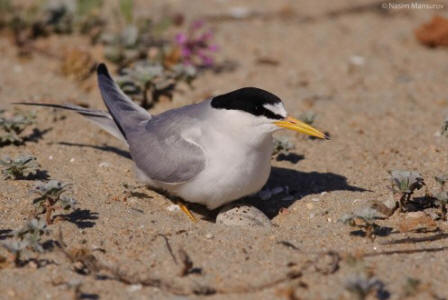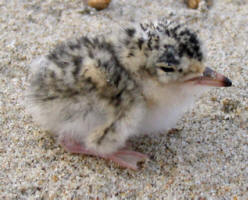Sterna antillarum browni
- Endangered – Endangered Species Act (1970)
- Endangered – California Endangered Species Act (1984)
The California least tern is a seasonal resident of California from April to September. After wintering in Central and South America, the terns arrive in the summer to breed beginning in early April each year. There are three recognized subspecies of least tern (including the eastern and interior least tern) but the California least tern is the only one that resides in this state. Tern breeding habitat extends from the San Francisco Bay south to Baja, California. One study estimated that around 59% of California least terns return to the same nesting spot each year.
Recent surveys have shown that no California least terns reside on Forest Service lands in the state, but two areas considered potential habitat for this species are Pfeiffer and Sand Dollar Beaches on the Monterey Ranger District of the Los Padres National Forest, totaling approximately 8 acres of habitat. One additional site – San Carpoforo Creek mouth – was recently acquired by the Los Padres National Forest and has potential to be used by California least terns (it hosts a population of western snowy plovers, which are often “dune-mates” with the tern.) Currently, the closest breeding site to National Forest System lands occurs at the mouth of the Santa Maria River, approximately 21 miles west of the Los Padres National Forest border.
Habitat
Terns require an undisturbed stretch of sparsely vegetated sandy or gravelly ground near a lagoon, estuary or bay in order to nest. California least terns make simple, shallow depressions in the ground to lay their eggs, occasionally decorating it with a few pebbles, shells or debris. The terns prefer very low vegetation densities; unfortunately this leaves nests in the open and blended with the sand, making it difficult for passersby to avoid them.
California least terns breed as monogamous pairs laying eggs in mid-May, but settle in loose colonies on the beach of usually 20 to 50 pairs. Terns hunt for food in shallow water bodies and take turns feeding their young. Chicks are hatched and raised during the summer months, usually 2 to 3 per nest. They can fly within 28 days and all of the birds including fledglings depart in mid-September, wandering a bit before migrating south for the winter.
Threats
The open, sandy beaches that California least terns migrate to for the summer are also highly prized real estate along the coast of the Golden State. Habitat loss is a pressing threat to the species. In addition, encroaching development near beaches and estuaries increases access of predators like dogs, cats, crows, skunks, foxes and raccoons to tern nests. Larger birds of prey such as burrowing owls, peregrine falcons and American kestrels may feed on terns. Recreational use of beaches is another disturbance to California least terns particularly because their nests lie in sand or mud underfoot. Even if not directly trampled, beachgoers and their pets can disturb the sand and dune habitat making it unsuitable for nesting.
Conservation
The tern was formally listed as “endangered” under the federal Endangered Species Act in 1970, and under the California Endangered Species Act in 1984. The U.S. Fish & Wildlife Service prepared a Recovery Plan for the California least tern in 1985, and in 2006 reviewed the status of recovery efforts to date, finding that that there are enough pairs of terns to meet the recovery goals of the 1985 plan, significant risks to the species still exist. Over 70% of California least terns reside on just five nesting sites and the reproductive rate of the species remains lower than the goal identified in the recovery plan.
As biologists continue to work to recover California least terns to healthy population levels, efforts are underway to protect current nesting areas using signage, fencing, chick banding and other habitat enhancement measures. In addition, the endangered western snowy plover shares similar habitat to the tern and both may mutually benefit from conservation efforts for either species. Restricting access to nesting sites on beaches is a common practice and reduces disturbance to breeding pairs while also keeping out certain predators. Fencing is an especially important piece of the species recovery puzzle—in places where fence has been removed or damaged a complete loss of a breeding season (no successful chick survival) has been seen to occur. Developing and implementing secure nesting site management plans is critical to protect the integrity of these few remaining nesting sites for the California least tern.








